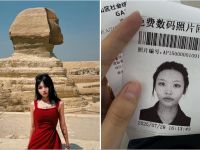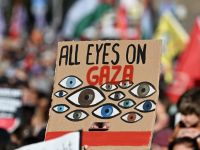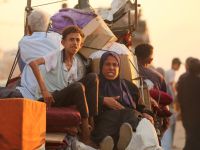For the most part, the Iranian press reports describing the ceremonies on February 10 marking the 22nd anniversary of the Islamic Revolution focused on what is regular fare at a mass demonstration in Tehran. They spoke of thousands of people in Azdi Square, carrying the national flag and posters of the late Ayatollah Ruhollah Khomeini, Iran’s current spiritual head Ayatollah Ali Khamenei and President Mohammed Khatami. As usually is the case on such occasions, calls were made against Iran’s two arch-nemeses—the United States and Israel.
The press was less expansive when it came reporting about armed police clashing in the Iranian capital with about 3,000 protesters, holding banners reading "We are against the Islamic regime." Some 20 people were injured and 100 were arrested. Similar demonstrations also took place in the western cities of Urumieh and Qazvin and the eastern city of Bojnurd
The night before, AFP reported witnesses describing two strong explosions in northern Tehran, near Mellat (People's) Park adjacent to Vali-Asr Avenue, the city’s major north-south artery. In January, the Baghdad-based People's Mujahedeen claimed to have perpetrated two mortar attacks.
This latest violent outburst represents the most widespread incidence of public unrest since the pro-democracy riots in July 1999. They ended when Iran’s reformist head of state, President Khatami, sided with the country’s religious establishment in squashing the uprising.
But in his speech on Saturday to mark the anniversary of the 1979 Islamic Revolution, Khatami was extremely critical of the dogmatically conservative approach of the clergy. And the Iranian president seemed to pointing a finger directly at Ayatollah Khamenei, when he said, "Rigid-mindedness is a main threat to the revolution and the Islamic republic.”
Khatami, sources say, blames Khamenei for blocking much of the reformist legislation his government has tried to pass. "Those who claim a monopoly on Islam and the revolution, those with narrow and dark views, are setting themselves against the people," the Iranian president said. "They are putting [religious] values against the wishes of people, religion against freedom and disregarding the rights of people. They seek to suppress views that are not in agreement with their own narrow and dark views."
The discontent of Iran’s younger generation could in time threaten the very foundation of the Islamic state. For the most part, its members do not remember the popular movement that took to the street in the late 1970s, eventually bringing about the overthrow the Shah. It instead judges the current regime on its own merits, and for what the youth sees is a system that clamps down on most forms of public expression—in the past year about 30 liberal newspapers were shut down—and a system that has failed to provide a decent standard of living, despite the fact that Iran is sitting above some of the world’s most valuable oil reserves.
Iran has been struggling with a lackluster economy ever since the founding of the Islamic republic. Ten years ago, the government’s chief financial advisors, with the assistance of economists from the International Monetary Fund, drew up a plan for structural reform—the first step of which involved the devaluation of the rial. But the political establishment led by then-President Ali Akbar Hashemi Rafsanjani balked, fearing the social consequences of rising inflation and unemployment.
Rafsanjani had attempted to introduce limited economic reform, and after winning re-election in 1993 his central bank governor announced the privatization of 20 banks to encourage more foreign investors. But Rafsanjani discovered that his political authority was limited because the Iranian parliament and constitution forbade foreign investment. Talks with the IMF were initiated in hope of obtaining loans, but that came to naught because of the dilemma.
The election of the reformist Khatami in 1997 gave rise to hopes that the program of structural reform would finally be adopted. But the new president found himself blocked by the religious leadership, who constitutionally had the power to veto any legislation he introduced.
The reformist parliament—or Majlis—that was elected in early 2000 has also taken up economic reform, and in particular has been looking at the issue of state subsidies. For example, the Majlis is trying to eliminate $1 billion in flour subsidies, which keep the price of bread low, but at the same time cause considerable wastage and the smuggling of flour to neighboring countries. But in respect to latter practice, the parliament has been finding itself fighting an uphill battle. Corrupt officials, who profited handsomely for the old system and who are an integral part of the establishment, are doing their utmost to ensure that nothing changes.
There was a moderate improvement in Iran’s economic situation in 2000, with the gross domestic product growing by 4-5 percent, its highest rate in years. Unemployment was down by about 1 percentage point, although it remained very high. The official unemployment rate ranges between 12 and 16 percent, but the real rate is considerably higher. Inflation was also down, from an annual average of about 20 percent to 15 percent in 2000.
But the more optimistic economic figures seemed to have little with a structurally sound Iranian economy, and everything to do with the dramatic rise in the crude oil price that took place during 2000. Because of the soaring cost of crude, the first half of the 2000/2001 fiscal year saw a record surplus of $6.7 billion. If the price of oil were fall, so would the fortunes of the Iranian economy.
Iran today is increasing attempts to open its economy to the outside world, but with only modest success. Speaking to the Aftab-e-Yazd daily, Merhdad Motamedi, a representative of the country’s chamber of commerce, revealed that Iran ranks 154 out of 160 countries in attracting foreign investment. According to Motamedi, Iran received less than one-10th of 1 percent of worldwide foreign investment, and most of what it received was oil related. To make matters worse, he continued, the country was suffering the ravages of capital flight, with at least $200 billion of Iranian money invested elsewhere, and some 3,000 Iranian companies registered in the United Arab Emirates. In the last three years, Motamedi said, Iranians had invested some $13 billion in Turkey.
The government’s attempt to avoid political ferment will largely rest on its ability to maintain a level of growth that at least keeps pace with the needs of population, which in 1998 was growing at 1.7 percent per annum. According to Mehdi Navab, an Iranian economist, to attain the 6 percent growth rate required by the Third Development Plan, the country needs foreign investments of $14.5 billion annually between now and 2005. That could be an extremely tall order. During the period running from January 1994 and December 2000, total foreign investments equaled $2.6 billion.
Khatami, who is nearing the end of his first term in office has still to indicate whether he will seek another four years in office when presidential elections are held in June. Popular support for a second term is growing, but sources close to the president say that part of his hesitation in announcing that he will run stems from the frustration that he felt in office, caused by constantly being stymied by the religious establishment.
Whether Khatami runs or not, the next president is likely to be a reformist. But he, too, is likely to find himself shackled by the conservative clergy. This is likely to fuel further the people frustration with the political system and the apparently moribund economy. – (Albawaba-MEBG)
© 2001 Mena Report (www.menareport.com)







